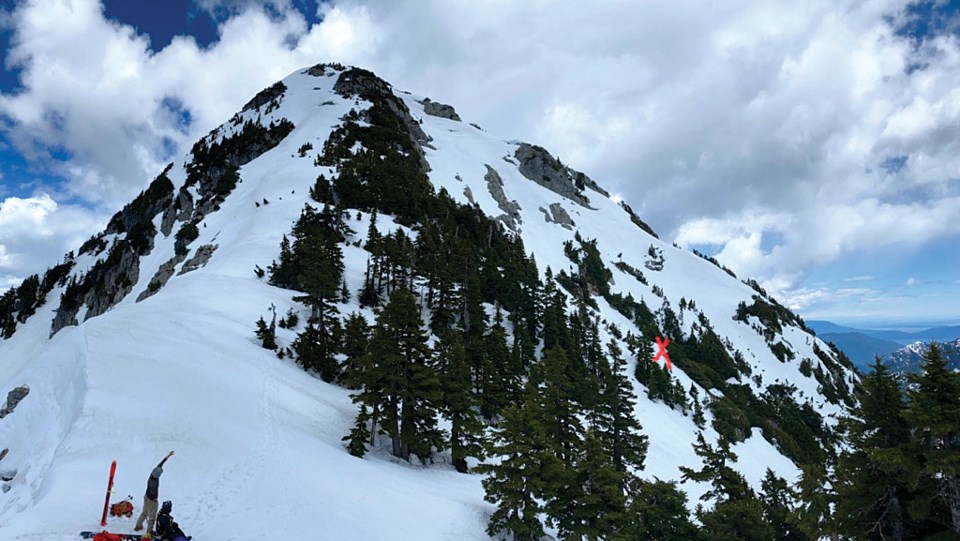A late spring ski excursion in Tetrahedron backcountry ended with a dramatic rescue the afternoon of May 20 – and lessons learned for the two experienced Sunshine Coast skiers involved.
Friends Reece Armstrong, 22, and Ben Turner, 33, had driven up the Rainy River Forest Service Road near Port Mellon for a daytrip to Tetrahedron Provincial Park, but by midday found themselves in a serious situation: Turner crashed while descending the southwest slope of Tetrahedron Peak.
The skier “hit a rock and launched and it was not a soft landing,” Sunshine Coast Ground Search and Rescue (SAR) manager Alec Tebbutt told Coast Reporter.
The SAR team responded to the skiers’ 12:15 p.m. cellphone call with helicopter and technical support from North Shore Rescue, including an ER doctor and an avalanche technician from Squamish, in order to provide a winch extraction.
Other members of the ground SAR crew, meanwhile, were staged at the Sechelt Airport.
Armstrong set up his skis in a clearing on the slope to create more visibility for the AS365 Talon Helicopter. “Even though it seems obvious that a helicopter can see people, it’s actually very difficult from the air,” said Tebbutt.
Following an assessment, Turner was flown to Lions Gate Hospital before being transferred to Vancouver General Hospital due to the seriousness of his injury – which was later identified as a complex hip fracture. Turner remained in hospital as of May 26 but was in good spirits, said Armstrong.
After transferring Turner to the city, the helicopter returned to fly the remaining crew and Armstrong off the mountain.
In total, 13 Sunshine Coast SAR and five North Shore crew were involved in the rescue.
Clear conditions helped keep the rescue straightforward, according to Tebbutt, who also noted the skiers had plenty of backcountry experience.
Following the rescue, Armstrong told Coast Reporter in hindsight the pair should have used their satellite device to make an emergency call since it provides an exact location to first responders.
“The issue was getting the service on the phone because it was so spotty up there. That’s where it became a problem, actually getting into service to receive the call from Search and Rescue so they could get our location. Had we pushed the satellite phone, they would have had the location already,” said Armstrong.
The pair’s knowledge of the provincial park also assisted with the rescue.
“On the first phone call, the first thing I relayed was exactly where we were, the elevation,” said Armstrong, who added a first responder also familiar with the area was able to help locate the skiers because he knew where cellphone reception exists on the mountain.
As for takeaways, Armstrong said: “Things can happen regardless of your experience level and terrain assessment,” so bring more gear than you think you’ll need.
“We were prepared to spend the night,” he said, “but there’s definitely some things I look back on that we had left to shed weight to move faster, and that three or four pounds is something I’ll never consider an option anymore.”
Call volume for the Sunshine Coast ground SAR team has been even higher than in 2020, according to Tebbutt. Last year the team saw an increase of 50 per cent above pre-pandemic volumes. In February 2020 – the last time SAR responded to a call on Tetrahedron – the SAR crew worked with a helicopter crew from the 442 Transport and Rescue Squadron out of Comox to extract an injured girl with a broken leg from the Batchelor Lake cabin.
Another significant operation the team was involved in this year included one earlier this May, when seven members, including the K9 team, assisted on a search for UBC professor Sinikka Gay Elliott on Salt Spring Island, while Royal Canadian Marine-SAR Station 14 out of Gibsons provided logistical support. Elliott’s body was found on the island on May 15, three days after she went missing.


